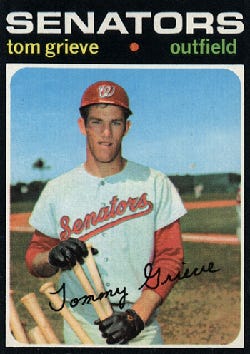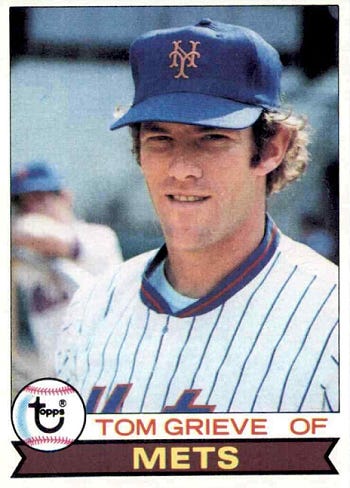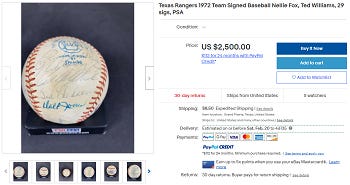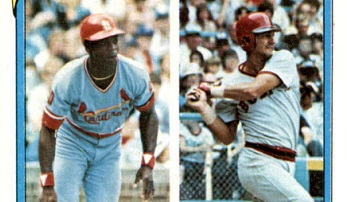If you’ve followed baseball for the last 30 years or so, then the name “Tom Grieve” is undoubtedly a familiar one to you.
From 1984 through 1994, after all, Grieve served as general manager of the Texas Rangers and pulled off some of the game’s most intriguing trades during that run …
Mitch Williams to the Chicago Cubs in exchange for Rafael Palmeiro and Jamie Moyer in 1988 …
Jerry Browne, Oddibe McDowell, and Pete O’Brien to the Cleveland Indians in exchange for Julio Franco, also in 1988 …
Trading away Sammy Sosa (1989) and Robb Nen (1993) …
Grieve was also at the helm when the Rangers signed Nolan Ryan as a free agent after the 1988 season.
The GM wasn’t all work, though, and his personal life came to the fore the year after Ryan put the finishing touches on his legendary career.
As Grieve was wrapping up his tenure in the Rangers’ front office, his son, Ben Grieve, made a splash as the 2nd overall pick in the June 1994 draft out of high school. Then, while Ben was working his way up through the Oakland A’s farm system — and then his Rookie-of-the-Year-winning season in 1998 — Tom moved over to the Rangers broadcast booth.
But, before his wheeling-and-dealing, before becoming famous as a father, before lending his actual voice to the Rangers, Tom Grieve had himself crafted a Major League playing career.
His team? Probably no surprise that it was the Texas Rangers … mostly.
Like his son, Tom was a first-round pick out of high school (sixth overall) back in 1966, selected by the Washington Senators.
Four years later, Grieve made his debut with the Sens, appearing in 47 games in the last half of 1970.
He spent all of the next season back in the minors, but his short stint in the bigs was enough to snag him space in the 1971 Topps set:
Find Tom Grieve cards on eBay (affiliate link)
Find Tom Grieve cards on Amazon (affiliate link)
Then, in 1972, Grieve broke camp with the Senators … except they were no longer the Senators.
During the offseason, the Senators picked up and moved to Arlington, Texas, becoming the Texas Rangers.
In the Rangers’ second-ever game, a 5-1 win over the California Angels at Anaheim Stadium on April 16, Grieve drew the start in left field.
The 24-year-old went 1-for-4 that day.
It was an up-and-down season for the man would someday be the Texas boss, but he stayed with the Rangers all summer … starting some games, substituting in during others.
It was the same story over the next few seasons, but his playing time increased when the Rangers fired manager Billy Martin in 1975 and replaced him with Frank Lucchesi.
In 1976, Grieve claimed the starting designated hitter role and delivered 20 home runs and 81 RBI, both career highs.
Alas, big league managers aren’t built to last, and Lucchesi was gone halfway through the 1977 season, taking with him most of Grieve’s playing time — his appearances dropped from 149 in 1976 to 79 the next summer.
Along the way, Grieve established himself enough that he became a regular part of the yearly Topps lineup and even made appearances in the 1976 and 1977 Hostess sets.
But, as he approached his 30th birthday, and with his playing time dwindling, it was probably little surprise to Rangers fans to see one of the team’s founding members (in Texas, at least) on the trading block in the winter of 1977-78.
As it turns out, the deal that landed Grieve with the New York Mets was epic and complex. To wit, n December 8, 1977 …
- The Rangers sent Grieve and a player to be named later to the Mets.
- The Rangers also sent Tommy Boggs, Adrian Devine, and Eddie Miller to the Atlanta Braves.
- The Braves sent Willie Montanez to the Mets.
- The Rangers sent Bert Blyleven to the Pittsburgh Pirates.
- The Pirates sent Nelson Norman and Al Oliver to the Rangers.
- The Mets sent Jon Matlack to the Rangers.
- The Mets also sent John Milner to the Pirates.
That PBTNL turned out to be Ken Henderson, whom the Rangers sent to the Mets on March 15, 1978 … less than two weeks after Grieve turned 30.
Obviously, there were some superstar players involved in that trade, and their impacts were huge, before and after they relocated.
For Grieve, though, it didn’t change a lot — he made it into 54 games with the Mets in 1978, hitting .208 with two homers.
That winter, New York traded him and Kim Seaman in a much more conventional transaction, receiving Pete Falcone from the St. Louis Cardinals in return.
In 1979, Grieve made it into just nine games before the Cards released him in May.
Less than two weeks later, though, the future — and past — came calling when the Rangers signed him to a minor league deal.
Grieve spent the rest of that summer with the Triple-A Tucson Toros before retiring as a player, but as far as unsuspecting collectors knew, he was still a Major Leaguer, and still a New York Met:
Find Tom Grieve cards on eBay (affiliate link)
Find Tom Grieve cards on Amazon (affiliate link)
Sort of fitting, given that the trade that made him a Met was complex enough to make his future-GM head spin.
As it turned out, that future lay just ahead, as Grieve joined the Texas front office after the 1979 season and did some broadcasting in 1980.
It was a quick run to the top of the Rangers’ organization from there, and Grieve is known these days a Texas lifer — no matter what his last baseball card says.
Hobby Wow!
Those 1972 Texas Rangers weren’t very good, but they were historic … and so was their coaching staff.
With manger Ted Williams and coach Nellie Fox, that Rangers brought some Hall of Fame swagger to the dugout — and to memorabilia like this:
That’s an autographed team ball from that first Rangers team, including Williams and Fox.
Check out the full listing on eBay right here (affiliate link).

1979 TOPPS BASEBALL CARDS #'S 401-600 YOU PICK - NMMT + FREE FAST SHIPPING!!
 | $1.00 End Date: Monday 05/06/2024 20:08:11 EDT Buy it now | Add to watch list |
1979 Topps Baseball Cards (1-199) - Pick The Cards to Complete Your Set
 | $1.05 End Date: Monday 05/13/2024 12:49:44 EDT Buy it now | Add to watch list |
1979 Topps Baseball Cards (200-399) - Pick The Cards to Complete Your Set
 | $1.00 End Date: Tuesday 05/14/2024 20:39:07 EDT Buy it now | Add to watch list |
1979 Topps Baseball Cards (400-599) - Pick The Cards to Complete Your Set
 | $1.05 End Date: Thursday 04/25/2024 15:00:04 EDT Buy it now | Add to watch list |
1979 Topps Baseball Cards ( 401-600 ) VG-NM You pick the card. Free shipping
 | $0.99 End Date: Friday 04/26/2024 23:49:16 EDT Buy it now | Add to watch list |
1979 Topps Baseball Cards ( 201-400 ) VG-NM You pick the card. Free shipping
 | $0.99 End Date: Wednesday 05/15/2024 02:07:09 EDT Buy it now | Add to watch list |









Recent Comments